[This is part of a series from the South America compilation]
Thank you for your interest in this site. Please note that all images are copyright protected and not available for use without permission. Please contact journeys@tenthousandcranes.com for any inquiries about the information contained in this site.
________________________________________________________________
Rumor had it that the best way to smooth out bumpy rides on South American mountain roads was to drive faster. Thus the six-inch strip of road that separated us from the plunging hillside raced alongside our tires like a snake on “speed.” We were well into our journey over the Andes toward the rainforest; Cusco lay miles behind and chance encounters lay ahead.
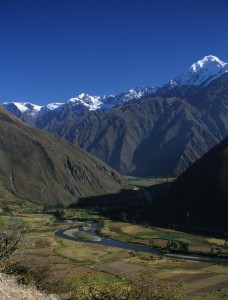
Valle Sagrado
As with many mountains, one side can be considerably different from the other. The ascent from the drier Sacred Valley had taken us well above treeline, through a landscape devoid of much growth, save for hardy native grasses that velveted the winter-dried terrain in a color resembling faded sunlight in a jar. Occasional stone corrals and huts punctuated the eerie luminosity of the dormant grasses, startling us with the reminder that people lived in this desolation. I could not fathom what sustained them through the winter. The highway was only recently partially paved, so frequent forays to the Valley miles below these 10,000’- to 12,000’-elevation huts seemed unlikely, as did pockets of cash with which to purchase anything.
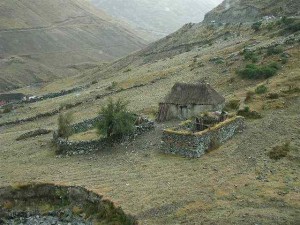
Stone huts - Abra de Malaga Pass
The few people living in that surreal landscape, in their red and mish-mash assemblage of clothing, offered testimony to the stoic tenacity of the poor. They seemed part of the endless cycles of people living with the land, nurtured by an intuition that guided them through seasons of new llamas, new babies, new grasses, each shadowed only momentarily by the passing of whatever might have been old, no time in their labor-driven days to dwell on losses and grief.
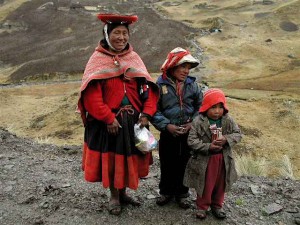
Family receiving supplies
My small group was on an “off-the-beaten-path” journey through the cultural landscapes of Peru and Bolivia, engaging with farmers, squatters, and street children to better understand the parallel worlds of those tethered to an informal economy where survival depended on the resolve of their souls. So we were captivated by the distant dots of people moving about their daily tasks on the remnants of earth left for them.
It felt as if we had been granted passage, given the right to witness the subtle movements that brought life to this landscape. Wanting to acknowledge them in some way, we made several roadside stops when we saw movement around the huts. Waving their tiny figures toward us, we watched them bob for great distances across uneven ground as they ran toward where we had stopped, their movements creating the only micro bursts of color across the otherwise dried terrain. The children would come first. We gave them small bags of school supplies, promising to stop again on our return.
Not used to tourists, their appreciation was humbling. The paving of the road will likely bring more visitors their way, even in this more remote crossing of the Andes. I wondered how much this might change their lives, if their huts and corrals would move closer to the road for faster access, and if they would fall victim to the tourist dependency of many whose only income stemmed from posing for photos, taking them away from any other more sustainable endeavor. I hoped that somehow their lives would become easier without succumbing to the trappings of tourism and development, remembering, however, that we, too, were tourists, leaving our mark on their lives. Wisps of snow began to fall, dusting our path behind us as we continued our climb over the summit.
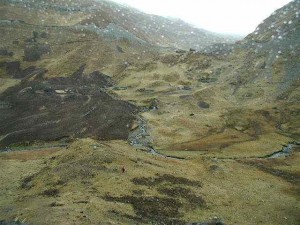
Snow begins to fall as we approach the summit
With every new mile of the descent, we found ourselves in a transformed landscape. New imagery replaced old; what had been barren and rocky only a short while ago gave way to verdant brush and crawling clouds. One could not tell what had birthed those clouds: sky or earth. Clouds literally rolled, danced, and tumbled over the terrain, like slinkies made of mist. Cloud Forests are a phenomena created by the perfect mix of climate, elevation, and rainforest, all coming together in a wondrous, repeating cycle of dragon’s breath. These massive gossamer displays dance over the eastern Andean hillsides.
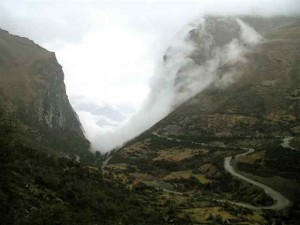
Cloud forests emerging from the mountain sides
We pulled over again, this time to gape. Exiting the van was an experience much like stepping out of an airplane into a cloud. I was struck by the knowledge that the mistlets running down my brow and arms were about to become infant drops of the Amazon River. As the dense mist embraced the ground, it turned quickly into rivulets that raced down the hillsides, carving notches in each roadside turn as they scrambled toward the waiting arms of young rivers. Melting snow in other parts of the Andes sent water scurrying down into Amazon tributaries, but in certain areas of higher elevation jungle, cloud forests were the pristine mothers of cascading streams and waterfalls. It was impossible not to stick out one’s tongue to taste a river in the making.
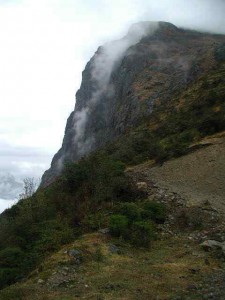
Approaching the cloud forest mist. These images don't capture a real cloud forest. It was too wet to take photos when we were amidst the clouds.
We continued our descent, eventually encountering occasional houses, this time made of scrap wood or disintegrating concrete, coated in faded turquoise and terra cotta pink. These were not postcard homes; pigs, chickens, and scraggly dogs foraged outside in wet soil. A child with blushed cheeks and runny nose poked a stick in the dirt. He was too young to work the fields and too old to be wrapped on his mother’s back. He barely looked up, mostly disinterested in our passage. While we fumbled for cameras, he continued to trace in the ground, not yet realizing that he was enjoying some of his last moments of childhood. In too short a time, he would be herding whatever animals the family might own.
Farther along, we approached rows of village houses. Small, dark, rotting doorways gaped like missing teeth in a mouth badly in need of repair. The locals stared at us, our gringo faces somewhat frozen in awkward smiles. Not many tourists passed this way; few had ever stopped. Most were on the other side of the mountain, doing their Machu Picchu thing. We emerged into the humid air, still grinning like painted dolls. Somehow smiling made us feel better when dropping in uninvited on a secluded town.
I was on a quest to interview some farmers and hoped that our meanderings would lead us to farming villages. Even though it was Saturday, we found the village Farm Committee gathered and enmeshed in sorting out their woes. I explained I was a professor of Cultural Geography, leading a small group. Surprisingly, we were invited in, perhaps because there were stories desperate to be told.
The polite but cautious farmers made room for us, moving back against the walls like pieces pushed to the edge of a chessboard. The worn planking of the now-emptied floor whispered secrets of these gentle people, most of whom wore the Peruvian staple of tire-tread sandals. Men, all shorter than I, told their stories slowly, each adding a part, much like building a fire stick by stick. A stooped man in last year’s shirt spoke with animation, punctuating the air with desperate gestures. I missed much in his hybrid Quecha-Spanish, but certainly felt his angst. Another spoke haltingly, as if uncovering new words from the floor under his slowly shuffling foot.
These were the tea people. They grew, harvested, and then processed tea, but there it lay in huge bulk bags like giant cocoons that never morphed because the village company could not afford the exorbitant middleman costs of tea bags. Tea bags . . . those tiny white discards that most people never quite knew what to do with. These people’s lives were on hold for want of tea bags. They had not been paid in over a year. The coyote middlemen had priced the bags out of the villagers’ reach and the farmers were not connected with any direct buying, even though their factory had one of the coveted contracts with the state to produce tea.
Each farmer continued with a part of the story. I asked how many were still growing tea. Only a few hands rose. A tiny woman stood in the doorway, a worn sweater hanging on her frame. Probably 35, she looked 60. She stood just enough in the doorway to assert her presence, but far enough back not to challenge the men. Her anxious eyes indicated that she, too, had a story to tell.
I asked the inevitable question of the men about how they were getting by. In somber tones they explained that they tried to grow other food, but had little money for seeds. They gestured to empty spaces in the room, as if pointing to ghosts of those who had abandoned their lands and fled to the cities, only to become squatters in an unfamiliar urban landscape.
Sunlight found its way through dirty windows, lighting the dusty air, revealing the spent spirits of these men as they continued to reflect on a friend or a brother who had left, unlikely ever to return. This was all the more disturbing given that land acquisition had only been so recently wrenched from the hands of post-colonial elites.
I braved the burning question: How many had turned to coca growing? I wasn’t certain if they would feel comfortable enough to answer, but they did. Probably seventeen of the nineteen hands went up. Coca is the mostly illegal plant that is shipped to waiting markets in the United States, either already processed, or soon to be, into cocaine. It was the crop that had thrown Colombia into chaos and insurgency. Only in one section of Peru was it legally grown. There its leaves were merely converted into a simple mate de coca drink used to combat altitude sickness and other health concerns. Historically coca was chewed, its caffeine-like qualities key to keeping indigenous slaves alive under colonial rule. Coca was also used in ritual. Its growing in Peru was carefully controlled by a government fearing the devastation that had chopped Colombia off at its knees. Policing a rainforest was no easy task, however, and many of these farmers had no choice but to turn to the more lucrative coca crop. But coca growing deforested hillsides, sending precious topsoil into rivers, silting the waters in ways that choked the fish and blocked light for aquatic plants. All for the want of tea bags.
The woman in the doorway shifted her feet, mouthing a silent story, punctuated by the occasional appearance of the few teeth in her mouth. The men’s stories continued, and I felt then as if the Amazon was seeded by both clouds and tears.
Someone suggested we visit the factory. As I stepped outside, the woman slipped her arm around mine, her story then to be told. She was the president of the mother’s club. One of her children had died, not uncommon in the village. There was no food, except the little that could be grown. There was no medicine. Babies died from diarrhea, one of the leading causes of infant mortality in the world. The woman spoke with a deliberateness, as if in telling her story just the right way, the ending would somehow be different. I understood her Spanish, or perhaps I just understand her eyes.
We toured the factory, roused by the delightful aromas of dried teas. I felt small and helpless; their poverty overwhelmed me, yet their spirit touched me. Once again, because we had stopped, because we had inquired, we had somehow woven ourselves into the tapestry of this village. We emptied our bags of gifts, mostly medical and school supplies. We raided our backpacks looking for more. They had not asked for anything; the gifts were again of our doing. They asked only if we could help them locate tea bags . . . tiny little white bags . . . bags that would allow them to stay on their land. The woman hugged me, holding on tightly, as if pressing her needs into me so I would take her prayers with me on down the road into the clouds.
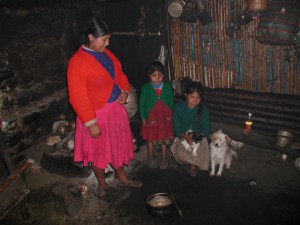
Inside hut going over Pass. Note guinea pigs behind woman. Woman offered us her only food...a pan of potatoes.
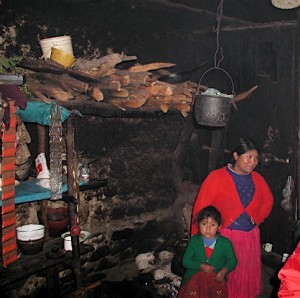
Inside
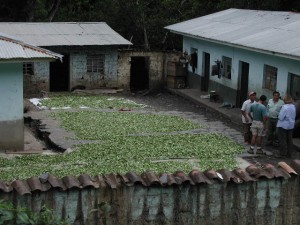
Coca leaves drying in sun
